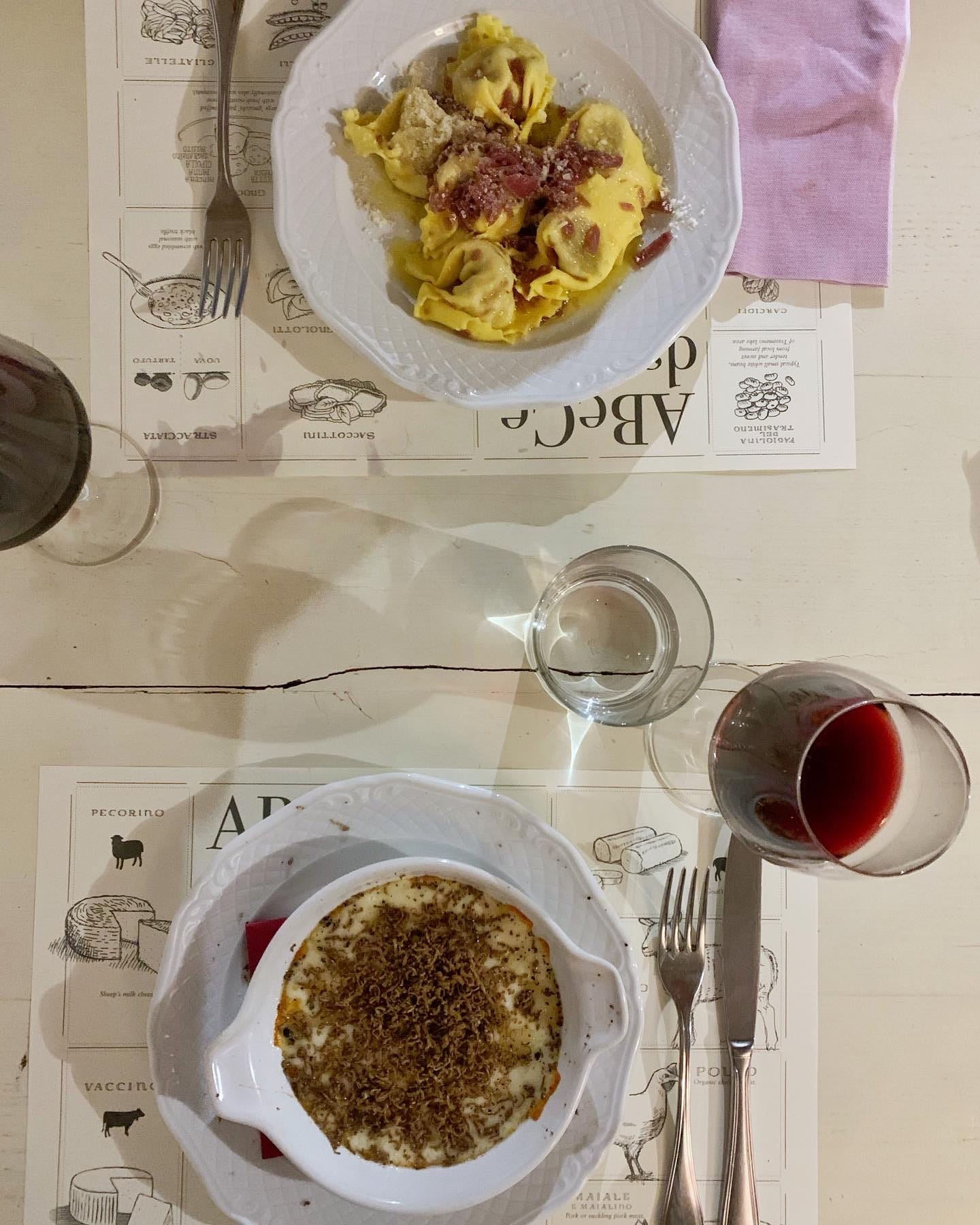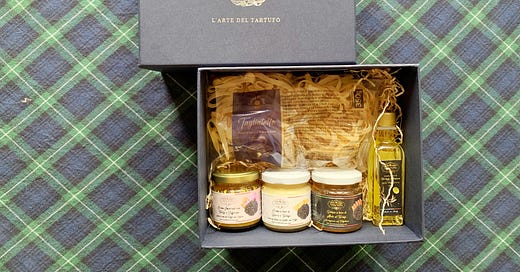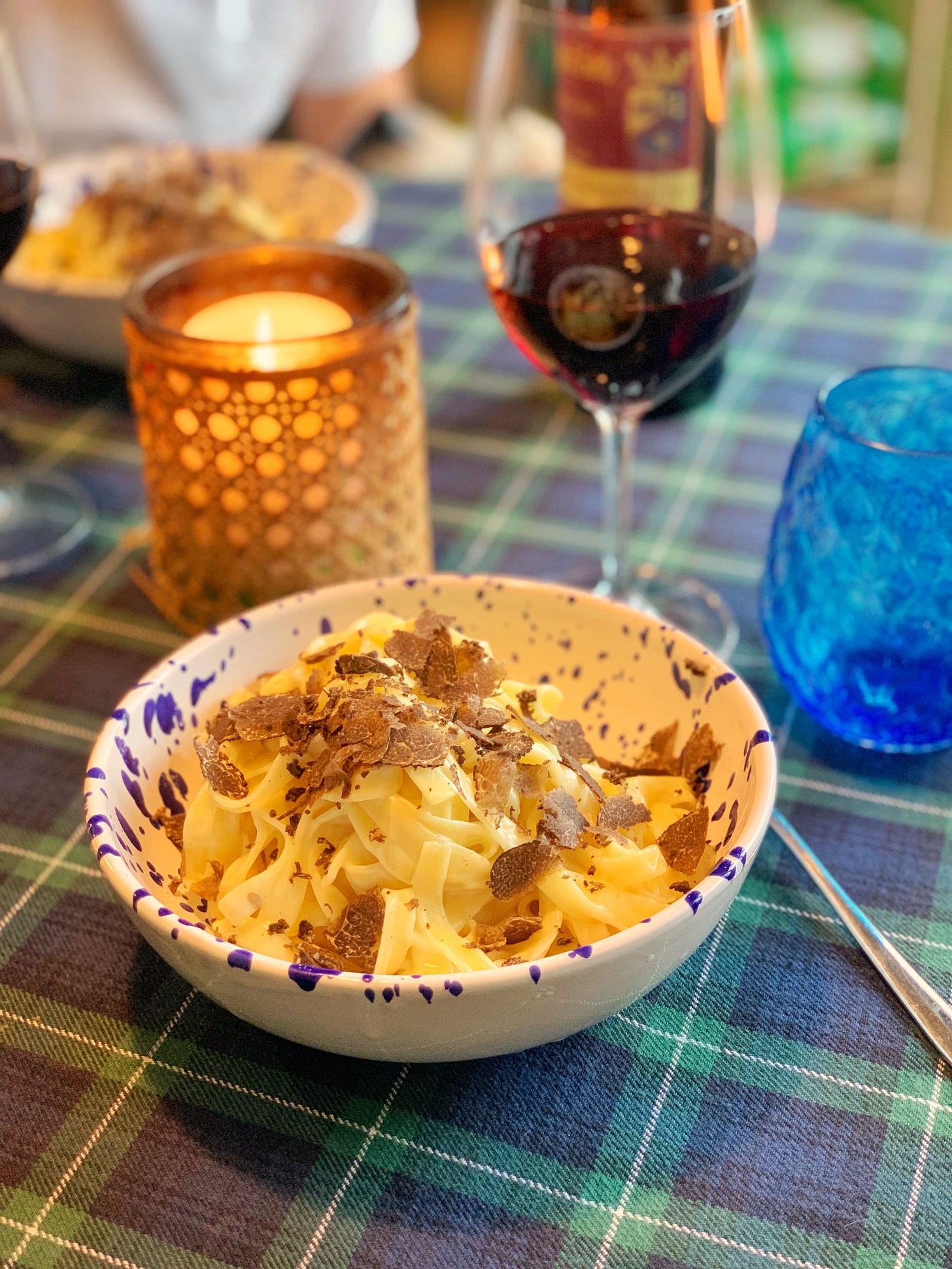It's truffle season in Italy and although it hasn't been a good year for truffles, the demand for them is higher than ever. In fact, it seems that the more they cost, the more people go crazy for them. As you may know, prized white truffles can sell for hundreds or even thousands of dollars. At Rocco Ristorante in Rome, where I had dinner last week, they were charging €50 for a plate of tagliatelle with fresh white truffle.
My husband Marco and I spent a weekend in Umbria earlier this month, where we indulged in some truffle-topped dishes like tagliatelle al tartufo nero at Trattoria da Volpelli just up the road from Vocabolo Moscatelli, where we were staying, and gooey melted cheese covered in shaved black truffle at Osteria a Priori in Perugia.
We also bought a cooking box and a 20-gram fresh black truffle from Tasting Truffles, which ships truffles and truffle-based products around the world. As we were chatting with the guy selling them, we learned about some common misconceptions about truffles. And as I was trying to figure out the proper way to store and use this precious fungus, I did some googling and was surprised by the lack of information from reputable sources, so I decided to put together a little explainer.
What exactly are truffles, anyway?
Truffles are a type of fungus that grows under the ground in symbiosis with a host tree, usually an oak or hazelnut tree. They’re found in a handful of places around the world, but the most famous truffles come from northern and central Italy as well as France. The city of Alba in Piedmont is particularly famous for white truffles and hosts an international truffle festival every year. Black truffles are commonly found throughout Umbria and Tuscany. White truffles are rarer, and therefore more expensive, than black truffles.
What do they taste like?
Truffles have a delicate earthy flavor that tends to get amplified in truffle-based products like sauces and oils. Black truffles taste a bit musky and nutty, while white truffles taste subtly garlicky.

Why are they so expensive?
Truffles grow spontaneously in the woods and take years to mature. Truffle hunters in Italy train dogs (often the Lagotto Romagnolo breed) to sniff them out and are very secretive about where they find them. They usually head out into the woods before dawn in order to prevent competitors from finding their spots.
During a trip to Piedmont a few years ago, Marco and I went for an afternoon walk in the woods with a truffle hunter and his dog, but I’ve heard rumors that they plant truffles in spots where the dogs can easily find them to impress tourists. In reality, foraging for truffles is hard work and fresh truffles spoil after about 10 days. So people put in a lot of time and effort to find a rare item that doesn’t last very long.
How to store and cook with truffles
A common misconception that was debunked by the Tasting Truffles vendor is that you should store fresh truffles in a glass jar on a bed of rice. According to this guy, the rice will dry the truffle out too much. Instead, he vacuum-sealed the truffle we bought in plastic and told us that if we didn’t use it all at once, we should just wrap it in a bit of dry paper towel and store it inside a glass jar. If you do this, just be sure to use it all within a few days or it will spoil.
When cooking with truffles, the key is to keep it simple. Truffles have a distinctive but delicate flavor that gets covered up by other strong flavors, which is why you rarely see truffles and tomato sauce together. Heat also kills the flavor, so don’t cook fresh truffles, but use a truffle shaver or grater to shave them onto a dish right before serving. In Italy, they’re usually served with fresh pasta in butter sauce, on top of eggs, or perhaps on a steak or melted cheese.
Truffle oil vs. truffle butter
If you have a choice between truffle oil and truffle butter, always go for the butter. Truffle oils are usually artificially flavored and don’t contain any actual truffles, whereas truffle butter is made with real truffles. It also works really well with pasta because of the way it emulsifies and creates a rich, creamy sauce when combined with a bit of the cooking water and some good parmigiano reggiano.
Where to buy them and brands to look for
If you live in the U.S., you’re most likely to find fresh Italian truffles at Eataly, which also sells a variety of truffle-based products. Urbani is one of the most common brands. I personally haven’t cooked with their products, but my friend Patricia Clark, a private chef who has lived and cooked in Italy, swears by them, especially the cream and truffles. She also recommends La Rustichella, saying, “I know many use it stirred into sauces, but I like it in a small dollop on top of a cheese tart, as a garnish for roasted vegetables, etc.” Personally, my favorite brand is Tartufi Morra, Alba’s original truffle purveyor. You can sometimes find their products at Eataly.
Further Reading
In case you missed it, check out newsletter issue #6, which was all about traveling in Piedmont and where to buy and eat truffles there.
Eataly has a pretty handle truffle guide, which I referenced for this piece.






